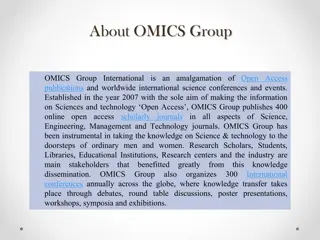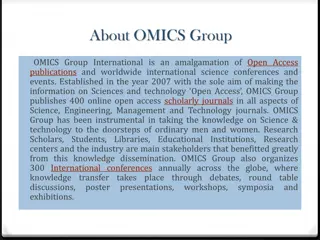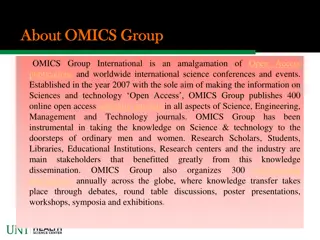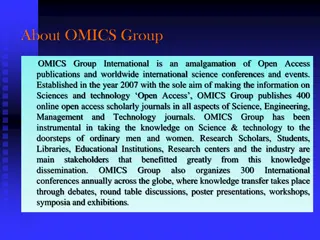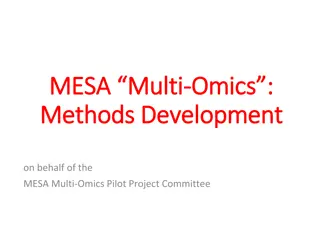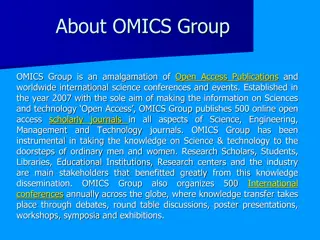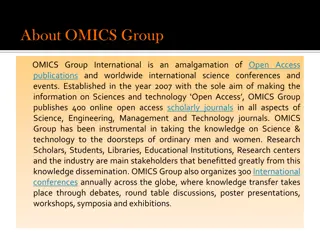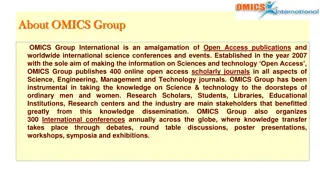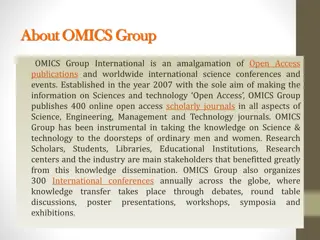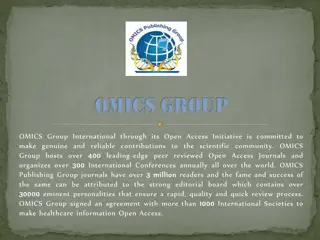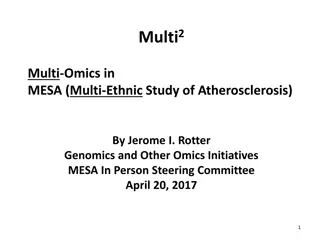OMICS Group: Open Access Publications and Science Conferences
OMICS Group International, established in 2007, aims to make science and technology information accessible through 400 online scholarly journals and 300 international conferences annually. Benefitting research scholars, students, and industries, OMICS Group organizes events worldwide, facilitating knowledge dissemination and discussions on various scientific topics.
Download Presentation

Please find below an Image/Link to download the presentation.
The content on the website is provided AS IS for your information and personal use only. It may not be sold, licensed, or shared on other websites without obtaining consent from the author.If you encounter any issues during the download, it is possible that the publisher has removed the file from their server.
You are allowed to download the files provided on this website for personal or commercial use, subject to the condition that they are used lawfully. All files are the property of their respective owners.
The content on the website is provided AS IS for your information and personal use only. It may not be sold, licensed, or shared on other websites without obtaining consent from the author.
E N D
Presentation Transcript
About OMICS Group About OMICS Group OMICS Group International is an amalgamation of Open Access publications and worldwide international science conferences and events. Established in the year 2007 with the sole aim of making the information on Sciences and technology Open Access , OMICS Group publishes 400 online open access scholarly journals in all aspects of Science, Engineering, Management and Technology journals. OMICS Group has been instrumental in taking the knowledge on Science & technology to the doorsteps of ordinary men and women. Research Scholars, Students, Libraries, Educational centers and the industry are main stakeholders that benefitted greatly from this knowledge dissemination. OMICS Group also organizes 300 International conferences annually across the globe, where knowledge transfer takes place discussions, poster presentations, exhibitions. Institutions, Research through workshops, debates, round table and symposia
About OMICS Group Conferences About OMICS Group Conferences OMICS Group International is a pioneer and leading science event organizer, which publishes journals and conducts over 300 Medical, Clinical, Engineering, Life Sciences, Phrama scientific conferences all over the globe annually with the support of more than 1000 scientific associations and 30,000 editorial board members and 3.5 million followers to its credit. around 400 open access OMICS Group has organized 500 conferences, workshops and national symposiums across the Francisco, Las Vegas, San Antonio, Omaha, Orlando, Raleigh, Santa Clara, Chicago, Philadelphia, Baltimore, United Kingdom, Valencia, Dubai, Beijing, Hyderabad, Bengaluru and Mumbai. major cities including San
Risk Assessment and School Violence: A Public Safety Paradigm Dr. Ronn Johnson, Ph.D.; ABPP Andrea Fessler, M.A. Candidate Alejandra Stepensky, M.A. Candidate Magdalene Wilhelm, M.A. Candidate University of San Diego http://acolumbinesite.com/sounds/911.wav
Overview High Profile School Shootings Scope of Impact School Resource Officers Safety Plan: How to Prepare Psychological Implications SRO Training and Effects Anti-Bullying
High Profile School Shootings May 18, 1927-Andrew Kehoe: Bath, Michigan April 20, 1999- Eric Harris & Dylan Klebold: Columbine High School April 16, 2007-Seung-Hui Cho: Virginia Tech University December 14, 2012-Adam Lanza: Sandy Hook Elementary
Scope of Impact Gun control laws: Who should be able to carry weapons in schools? Arkansas teachers For every school to have a SRO, taxpayers would be charged 13 billion a year, & half the federal budget for elementary/secondary education would be spent on this alone Safety Plans The value of School Police Prevention
School Resource Officers (SROs) Police specifically trained for working as law enforcement agents and educators in schools Roles include: Problem-solving partnerships Situational crime prevention Decrease violence Safety plans Crisis response planning Threat assessment Security and safety audits Sponsorship of youth activities Periodic in-school trainings and presentations (Raymond, 2010, p. 4).
School Resource Officers (SROs) Seen as trivial job by fellow officers o Often marginalized, isolated and disrespected by rest of police force Many school budgets cannot afford permanent employment of an SRO Sandy Hook impact o Had two SROs, Flynn and Penna o After Sandy Hook, Newtown s goal is to expand its School Resource Officers to have one officer in every school o Newtown currently lacks enough men to provide that need
NASRO Organizations such as National Association of School Resource Officers (NASRO) exist with the primary goal of preventing school violence: NASRO is an organization for school-based law enforcement officers, school administrators, and school security/safety professionals working as partners to protect students, school faculty and staff, and the schools they attend (NASRO.org)
Safety Plan: How to Prepare Prevent, prepare, respond Schools and organizations must come together to determine the plans of action. Schools and law enforcement must work together to develop realistic safety plans School Resource Officer (SRO) Must collaborate with the first response team Utilize available tools and technology
Training Joint effort of school staff and corresponding Law Enforcement Rapid Response System: Creates a web-based tool with photos and video of the school Immediate lockdown Color Card System Crisis Response Box (Will result in) less targets for the shooter(s), reduce confusion for arriving officers, help contain the situation, and minimize the chance of an accidental shooting by responding officers, (Williams). Pre-determined safety sites off campus Memorandum of Understanding Between the school and local law enforcement for procedural purposes Assures both parties understand the exact plan and tactics Increases chances that plan will be carried out Do not try to be a hero
National Incident Management System (NICS) Nationally recognized emergency operations plan that is adapted for large critical incidents where multi-agency response is required Goal: Allow law enforcement and school staff to respond together with quality communication and organization Promotes priority-setting, efficient communication, and interagency cooperation Systematic approach
Impact on School Environment Change in environment and mourned losses Community outreach External vs. internal threat Psychological Implications Potential Manifestations: PTSD Anxiety Depression Fear factor How do we detect the signs? Alienation Dramatic change in behavior Repeating the trauma through play and action Untrusting Changes in school performance Problems with friends Monitor social media and gaming
Support and Services Mental health services Group counseling with peers Individual counsel Provide other resources Accommodations on campus Family and Community Staff sensitivity training How can we support these students during this difficult time? What can we do to ensure they feel safe in this environment again?
Why do SROs Require Specialized Training? Referred to as a multifaceted hybrid breed Synthesizing responsibilities of law enforcement officer, counselor, teacher and mentor Parent teacher meetings Emergency response system protocol Crowd control and violence de-escalation tactics Liaison between law enforcement and the community Crisis prevention/intervention and post trauma crisis management/intervention
School Resource Officer Training No uniform duties or training currently exist State law and school district regulations vary, therefore compliance with such would vary as well Prominent and widely recognized organizations national organizations provide specialized training NASRO (National Association of School Resource Officers) COPS (Community Oriented Policing Services)
NASRO SRO Training 40 Hour basic instruction course Gang activity, drug abuse, self-destructive behavior etc. Crisis plan, emergency plan, threat assessment etc. Triad Concept Individual and classroom teaching skills School law enforcement practices Counseling and problem solving skills NASRO encourages enrollment in follow up classes 24 hour advanced classes 12 hour specialized classes (i.e. verbal de-escalation skills) Annual conferences
COPS SRO Training Pre-service training regiment Teaching, mentoring, counseling Working collaboratively with school administrators Application of juvenile law/case law Formal classroom training Shadowing experienced SRO s Offers follow up specialized training Special needs population training Establishment of anonymous tip lines Drug awareness campaigns Gang affiliation implications
SRO Relationships with Parents, Students and Community Parents & Students Greater respect and positive regard for officers Increased perception of safety in schools Greater comfort reporting crimes Value immediate response Community Enhances police reputation Greater comfort with and trust in officers Police Personnel Improve school safety Stronger relationship with community/school personnel Reduce workload of patrol officers
SRO Relationship Effects Cont. Potential pitfalls and future areas of caution for SRO s: Overly aggressive/authoritative officers Feelings of harassment/being treated like criminals Presence implies an inherent lack of safety at school Children feel they are under constant surveillance
Anti- Bullying Movement: A step Towards Reducing Violence Victimization Peer influence Healthy vs. foul play Safe2Tell SRO s influence Anti-bullying community campaigns Family involvement Profiling a shooter
References Associated Press (2013). Arkansas School District Arming More than 20 Teachers, Staff . Fox News: July 30, 2013.http://www.foxnews.com/us/2013/07/30/arkansas-school-district-arming-more-than-20-teachers- staff/ Brown, B. (2006). Understanding and assessing school police officers: a conceptual and methodological comment. Journal of Criminal Justice, 34(6), 591-604. Burgess, A., Garbarino, C., & Carlson, M. (2006). Pathological Teasing and Bullying Turned Deadly: Shooters and Suicide. Victims & Offenders, 1(1), 1-14. doi:10.1080/15564880500498705 California Emergency Management Agency. (2013). Active Shooter Guidebook: How to Respond. Retrieved from http://www.calema.ca.gov/newsandmedia/pages/ current%20news%20and%20events/school-safety.aspx. Christensen, Loren & Grossman, Dave. (2000). Preventing Violence in Our Schools . Killology Research Group. Retrieved from http://www.killology.com/school_notes_ preventing _violence.htm. DeMillo, A. (2013). Dustin McDaniel, Arkansas Attorney General, Says School Districts Can t Arm Teachers, Staff The Huffington Post: August 1, 2013. http://www.huffingtonpost.com/2013/08/01/dustin-mcdaniel-arkansas_n_3691600.html Editorial Board. The Slow Motion Inquiry into Sandy Hook . The New York Times: August 1, 2013.http://www.nytimes.com/2013/08/02/opinion/the-slow-motion-inquiry-into-sandy- hook.html Efron, L. (2012). Mass School Shootings: A History . ABC Nightline: December 14, 2012. Retrieved from http://abcnews.go.com/US/mass-school-shootings-history/story?id=17975571 Fairburn, Richard & Grossman, David. (2000). Preparing for School Attacks . Killology Research Group. Retrieved from http://www.killology.com/schoolattack.htm. FEMA: Federal Emergency Management Agency. (2012). National Incident Management System. U.S. Department Of Homeland Security. http://www.fema.gov/media-library/assets/documents/29009?id=6449.
References Cont. Finn, P. (2006). School resource officer programs: finding the funding, reaping the benefits. FBI Law Enforcement Bulletin, 75(8), 1-7. Finn, P., & McDevitt, J. (2005). National assessment of school resource officer programs. Final Project Report. Cambridge, MA. Retrieved from http://www.ncjrs.gov/pdffiles1/nij/grants/209273.pdf Finn, P., Shively, M., McDevitt, J., Lassiter, W., & Rich, T. (2005). Comparison of program activities and lessons learned among 19 school resource officer (SRO) programs. A report submitted to the National Institute of Justice. MA: ABT Associates. Retrieved from http://www.ncjrs.gov/pdffiles1/nij/grants/209272.pdf Finn, P., Abt Associates., & United States. (2005). A guide to developing, maintaining, and succeeding with your School Resource Officer program: Practices from the field for law enforcement and school administration (pp. 111-124). Washington, D.C.: U.S. Dept. of Justice, Office of Community Oriented Policing Services. Grossman, D. (2000) Trained to Kill, in Crime and Criminals, T. Roleff (ed), Greenhaven Press, 2000. Hill, E. (2013). The Cost of Arming Schools: The Price of Stopping a Bad Guy with a Gun . Cleveland State University: April 1, 2013. http://engagedscholarship.csuohio.edu/urban_facpub/678/ James, R.K., Logan, J. & Davis, S.A. (2011). School resource officers in school-based crisis strengthening student support. School Psychology International, 32(2), 210-224. Lawrence, T.F. & Coon, J.K. (2005). The Role of Law Enforcement in Public School Safety: A National Survey. Washington, D.C.: National Institute of Justice. (NCJ 211676). McDevitt, J. & Panniello, J. (2005). National assessment of school resource officer programs: survey of students in three large new SRO programs. Washington, D.C.: National Institute of Justice. (NCJ 209270).
References Cont. Myrstol, B.A. (2011). Public perceptions of school resource officer (SRO) programs. Western Criminology Review, 12(3), 20-40. Na, C. & Gottfredson, C. (2011). Police officers in schools: effects on school crime and the processing of offending behaviors. Justice Quarterly, 30(4), 619-650. National Association of School Resource Officers (NASRO). To Protect and Educate: Prevention of Violence in Schools . August 10, 2013. http://www.nasro.org Peters, J. (2012). We Still Look at Ourselves as Survivors More Than Eighty Years Later, Remembering the Deadliest School Massacre in American History . Slate: December 18, 2012.http://www.slate.com/blogs/crime/2012/18/bath_school_school_bombing_remembering_the_deadliest_school_massacre _in_american.html Raymond, B. (2010). Assigning Police Officers to Schools . Center for Problem-Oriented Policing. Response Guide No. 10. http://www.popcenter.org/responses/school_police/ Resmovits, J. (2013). Newton School Police: It Was So Real It Didn t Seem Real . The Huffington Post: July 16, 2013. http://www.huffingtonpost.com/2013/07/16/newtown- school-police_n_3601282.html Safe2Tell: CO Attorney General s Office. Retrieved from http://safe2tell.org/who-we-are/ Stolberg, S. (2013). Gun Victims Vow to Press on in State Legislature Political Campaigns . The New York Times: April 19, 2013. http://www.nytimes.com/2013/04/20/us/politics/gun-victims-vow-to-press-on-in-state-legislatures-and-political- campaigns.html?ref=arizonashooting2011&_r=0 Theriot, M. (2009). School Resource Officers and the Criminalization of Student Behavior . Journal of Criminal Justice Vol. 37 Issue 3. http://www.sciencedirect.com/science/article/pii/S0047235209000464 The Bully Society: School Shootings and the Crisis of Bullying in America's Schools. (2011). Publishers Weekly, 258(51), 43. Williams, John. (2013). Active Shooter Safety Considerations . Los Angeles County Sheriff s Department.
Q & A For any further questions we can be reached at: stepenskya@sandiego.edu afessler@sandiego.edu mwilhelm@sandiego.edu
Let Us Meet Again Let Us Meet Again We welcome you all to our future conferences of OMICS Group International Please Visit: www.omicsgroup.com www.conferenceseries.com



